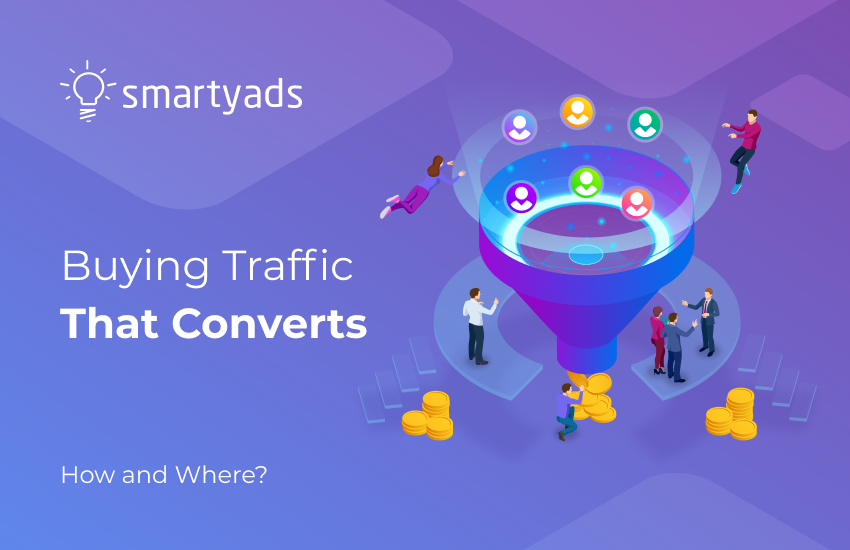Every minute, around 500 hours of content is uploaded on YouTube, 695,000 stories are counted on Instagram and 70 million messages are being received. Every business has to somehow withstand this competition to attract users to their websites.
One of the ways to catch users’ attention is to buy website traffic. It seems easy – you pay, put up some ads, and you are ready to conquer the market. However, every ad spot is a battlefield against your competitors, the content of the page, and other advertisers.
In this article, we want to give you a strategy for winning that cut-throat competition: learn how to buy web traffic, how to get the most out of your investments, and which practices to apply.
Key Takeaways:
- Buying high-converting traffic means paying for targeted website visits from audiences most likely to engage or convert, ensuring faster results than organic methods.
- Success depends on accurately defining the target audience, aligning ads with the buyer’s journey stages (awareness, consideration, purchase), and continuously testing creatives, targeting, and channels for optimization.
- Key quality metrics — bounce rate, session duration, conversion rate, ROAS, and cost per conversion — help assess whether the traffic is truly delivering value.
- Low-quality traffic leads to wasted ad spend, distorted analytics, low conversions, and potential brand damage, making fraud prevention and brand-safe inventory crucial.
- Top-performing channels include programmatic DSPs like SmartyAds, Google Ads, Facebook Ads, and reputable ad networks such as Adcash and Adsterra, each offering unique targeting and format options.
- Advertisers can maximize results with SmartyAds DSP, benefiting from global premium inventory, advanced targeting, fraud protection, and real-time campaign optimization to secure brand-safe, viewable, and cost-effective impressions.

What does buying traffic mean?
From the viewpoint of an advertiser, buying traffic refers to the practice of paying for visits to a website or app. This is typically achieved through platforms.
Instead of waiting for users to naturally discover a site through organic search results or social media, advertisers pay to have their ads displayed to specific audiences based on their search behavior, interests, or demographics. Each time a person clicks on one of these ads and lands on the site, it counts as a "paid visit."
For advertisers, the key advantage of this option is the speed with which it can generate visitors, whether the goal is to boost sales, build an email list, or promote a product. However, the real challenge lies in ensuring that the impressions have been bought correctly.

Tips for buying high converting traffic
Even though buying targeted traffic seems easy, you still have to know how to do it right. Otherwise, you might end up investing a lot of money in advertisements and not getting any response.
In order to avoid this unpleasant situation, we suggest preparing in advance and constantly getting better by following these tips.
Define your target audience
So you have two options: display your ads to every person on the Internet, pay millions, and attract a small percentage of website visitors, or show ads to a small number of targeted users that are potentially interested in your offer. The second is obviously more cost-effective and would result in higher conversion rates.
- Gender
- Age
- Location
- Job title
- Spending patterns
- Preferred communication channel
- Interests
In order to buy traffic for website, you also need to create a target audience persona.
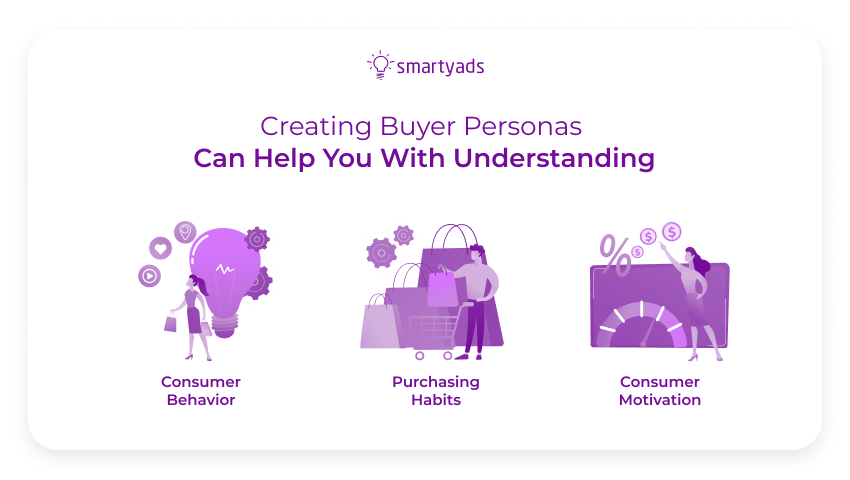
Finding out who is definitely not your target audience
It is not only about people who are opposite from your target audience but whose demographics and interests are close, but they will not be interested in your product or service.
If you know who your main audience is, you will be able to create more appealing and effective advertising and use the targeting options of the ad networks to the fullest. Below, you can see an example of how a company successfully defined its target audience for serving display ads on an ad platform. Thanks to such platforms, ad buyers can buy online traffic in RTB auctions effectively and automatically.
In addition to this, media buyers can track “web traffic buy activities” and change the campaign flow according to the dynamics and performance that they obtain.
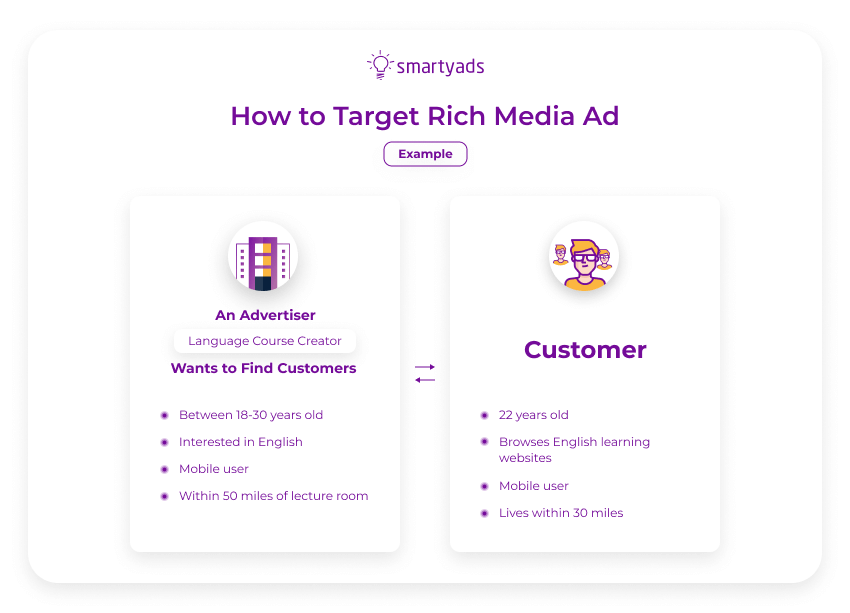
Align content with buyer’s journey
Buyers go through specific steps before deciding to make a purchase. At every step, you should deliver the content that they will find the most useful. Let’s take a look at those steps:
Awareness and discovery stage
At this stage, users acknowledge that they have a problem and start looking for solutions. Their intent is to find useful information and resources (they are not ready to buy yet). At this stage, you should provide educational content, meaning guidelines, how-tos, checklists, and informational videos. Your keywords should include “How to...”, “What to do if...”, etc. At this point, you will target the broadest audience.
Consideration stage
At the consideration stage, users already know what the solution to the problem is and start looking for several products and services to later compare them. Potential buyers want to know more about the product itself and what benefits it provides in particular. This is not the stage where they buy but rather read about different brands, so you have to make sure that your offer stands out among the competitors. You should create landing pages with a clear description of features and benefits. It should primarily be text ads and videos with strong CTAs. B2B buyers will also like to see case studies at this point.
Purchase stage
At this stage, users have accumulated enough knowledge and are ready to make a purchase. Marketers should focus on closing the deal. Spell out your benefits, locations, prices, ratings, and sales. You should also make sure that website visitors know how to become a customer: add “Shop now”, “Sign up”, and “Get a demo” CTAs and make the purchasing process as easy and straightforward as you can get. Commercial intent keywords are essential at this stage; they sound like: “Buy … laptops in (city’s name)”, “where to buy … laptops”, “... laptops review”, etc. The most fitting ad types are shopping ads with product photos, prices, reviews, and image carousels to show off the whole line of products.
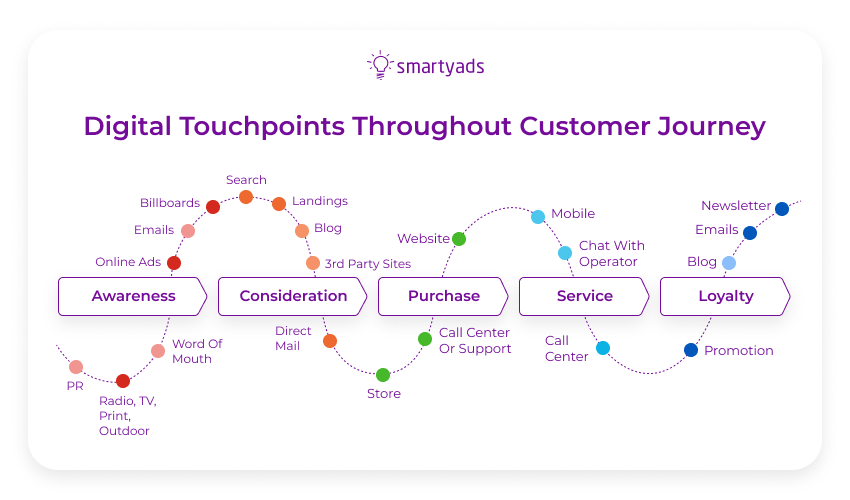
It is essential that you put up ads for every stage rather than aiming at the last one. If customers get to know you from the very first stage, they will know that you are an expert in the field and your brand’s name will be more familiar and, therefore, trustable than those of other brands.
Key metrics to measure traffic quality
Imagine that you attracted a really spectacular amount of impressions while leveraging several channels – affiliate marketing, paid advertising, social media marketing, and more. You might think, well, I’ve done a great job and gained the attention of my audiences. To find out if that is true, you need to assess the quality of what you’ve achieved.
If the performance is not so good, you may consider changing some things. This is essential because what we plan and assume does not always align with reality. After some time, it will be easy for you to interpret your performance on the platform and analyze “website traffic buy activity.”
Bounce rate
Bounce rate is a metric that shows the percentage of users who leave a website after viewing just one page without taking any further action. It reflects the user’s interest in the content or offer. A high bounce rate of 70%+ may indicate issues such as a poorly chosen landing page, weak content, an unclear offer, missing key information, ineffective pricing, and so on.
Session duration
With session duration, you can find out how long your potential audiences stay on the web page after they land on it. In other words, if they stay for a second or two and then leave (the session duration is short – < 1 minute), it clearly indicates that they ended up on your page by mistake.
Conversion rate
Conversion rate is a key metric for performance analytics. It shows how effectively the sales funnel on a landing page guides users toward making a purchase. It represents the ratio of visitors to customers, indicating what portion of users took the desired action—such as making a purchase, signing up, or completing a form.
If a website had 10,000 visitors and 300 of them converted, then the CR (Conversion Rate) is calculated as: (300 ÷ 10,000) × 100 = 3% (whether CR is good or bad depends on industry you are working in).
If the conversion rate is low or close to zero, it means users are clicking on the ads and landing on the site but not converting. The issue likely lies with the landing page or offer itself—where exactly the problem can be identified through testing.
ROAS (Return on Ad Spend)
ROAS, or Return on Ad Spend, basically tells you how much money you’re making for every dollar you spend on ads. So, if you spend $100 and make $400 back, your ROAS is 4 — meaning you earned four times what you spent. If your ads are bringing in tons of visitors but your ROAS is low, that usually means the impressions aren’t converting — maybe it's not the right audience or the offer isn’t resonating. The other situation is when you’re getting fewer clicks, but your ROAS is high, which means everything works well.
Cost per conversion
How much does it cost to attract a customer who makes some kind of action (gives you an email, sign-ups for your events, download an ebook, etc.)? It is calculated by dividing the total ad spend by the number of conversions (desired actions, like purchases or sign-ups). A low CPC (under $10 is good), as it indicates you're spending less to achieve each conversion, while a high CPC (above $50) means your ads are less efficient.
Dangers of buying low-quality traffic
Here's a list of problems associated with buying low-quality impressions, along with the potential long-term damage to ad budgets and analytics integrity:
- Low Conversion Rates: Visitors from low-quality sources are less likely to take the desired action (e.g., purchase, sign up, etc.), resulting in poor conversion rates.
- Higher Bounce Rates: Users from low-quality sources may leave the site quickly without interacting, leading to high bounce rates.
- Wasted Ad Spend: Money spent on low-quality web sources don't generate meaningful results, draining the ad budget without a return on investment (ROI).
- Distorted Analytics: Low-quality web sources can skew key metrics like average session duration and engagement, making it harder to assess real performance.
- Poor Audience Targeting: Buying low-quality impressions can indicate misaligned targeting, which means your ads are reaching people who aren’t interested in your product or service.
- Decreased ROI: As low-quality impressions don't convert well, the overall return on ad spend (ROAS) diminishes, leading to inefficient campaigns.
Aside from those drawbacks mentioned above, the brand risks ending up with reputational damages in case ads appear near or close to inappropriate content. The same applies to situations where web sources are spawning with suspicious bot activities. For this reason, it is important to ensure that the platform you select for media buying is collaborating with security providers who detect and prevent fraud on pre and post-bid basis.
Test and optimize
If you want to buy website traffic that converts, It is essential to be flexible. If you create an ad solely based on your research and two and never change it up, you are likely to experience losses or get the minimum out of your marketing efforts.
By tracking your KPIs, you will know what you need to optimize: target audience, ad visuals, and text, landing pages, channels, etc. Do not be afraid to cut off channels that only cause loss, to stop bidding on keywords that are too expensive and not bring any conversions, to pause ads in the most expensive times of the day, etc.
It is also important to test different visuals, channels, CTAs, audiences, etc. By doing so, you will understand what works best for your customers (colors, wording, time) and may discover the new niche of the audience that was never noticed by your competitors. A/B testing helps to find the most efficient way to buy high converting traffic and increase the number of visitors to your website.
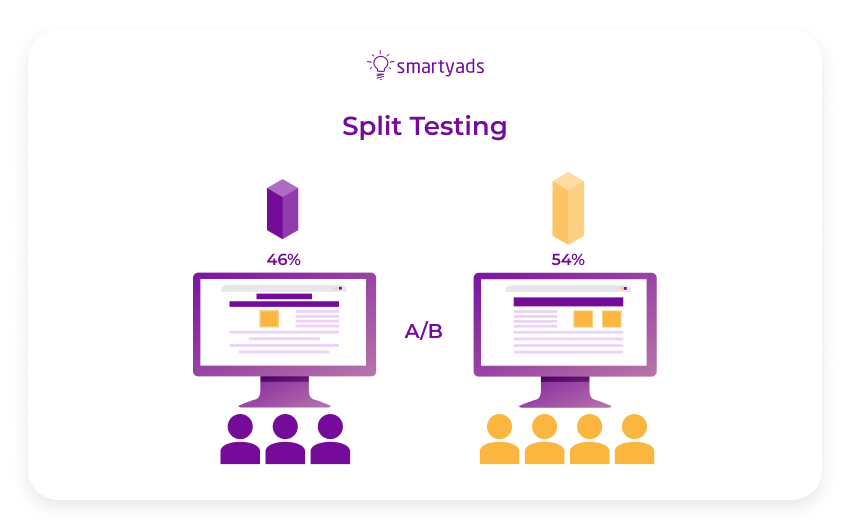
Learn how to convert web traffic
Are you sure you can convert the impressions that you get? It is important to create a website that is a logical continuation of your marketing efforts.
It should have a clean, responsive, and intuitive design, the landing page should be as attractive as the ad itself, the buying process should be very easy and straightforward.
We also recommend creating a mailing list. Those customers who are interested in your business but are not ready to buy yet will receive valuable content that will remind them of your products and build trust. In order to get a customer’s email, you can:
- offer exclusive content for the newsletter subscribers
- offer a community
- offer exclusive sales and coupons to newsletter subscribers
- use lead generation offers (ebooks, checklists, webinars, studies, statistics, infographics, etc.)
- share newsletter previews on social media
- create an appealing popup
Working together, advertising, email marketing, and good landing pages and website structure can do wonders to your return on ads spent and significantly lower your cost per acquisition.

Where to buy high-converting traffic?
So where is the high-converting traffic sold? What platforms are the best to run campaigns with? Let’s take a look at our top picks!
SmartyAds DSP is the best way to buy high-converting traffic
One of the best ways to buy high-converting traffic is to turn to Demand Side Platforms. SmartyAds is a good example of a reputable independent DSP that offers global coverage, access to major publishers, and, most importantly affordable CPM prices. The platform is among the most effective traffic sources for affiliate marketing or for driving traffic to e Commerce stores.
You can target users based on their demographics, geolocation, type of device, and operating system, etc. Retargeting options are available as well.
You can choose among such digital ad formats as banners, videos, native ads, rich media, connected TV, and push notifications. The pricing model of the network is the cost per mille.
Google Ads
Google reaches pretty much everyone with a computer or a phone because we all use Google as a search engine. From small children looking for cartoons to older people looking up recipes, we all use Google. There are 5,4 billion searches every day, meaning 5,4 billion opportunities to tell about your product.
Not only the impressive reach but precise targeting options and powerful analytics make Google Ads one of the most popular ad platforms for driving targeted traffic to your website. The keywords tool allows you to show ads only to people who are already interested in your industry enough to search for it on the search engine.
Google Ads works on a PPC (pay-per-click) basis. It means that you do not pay for users who see your ad and do not engage any further but for people who actually click on the ad. It is a great option if you target the right keywords and right audience, deliver the right content, and have good enough landing pages.
Otherwise, you might run into numerous clicks without further engagement and ruin your budget. So if you know how to work with PPC, buy high-converting traffic on this platform.
Facebook Ads
If you want to buy traffic that converts on social media Facebook ads might be your ultimate choice: Facebook, Messenger, Instagram, etc. Facebook has 2,7 billion monthly users, and Instagram engages 1 billion users monthly, meaning that if you want to buy traffic here, you will be able to reach a pretty impressive number of users and find your audience.
Facebook Ads allows you to create native ads that are almost identical to a normal social media post. This unintrusive ad format is okay with users, unlike popups. The targeting options are pretty amazing, too: you can target interests, behaviors, demographics, specific ages, locations, languages, or even fans of your competitors. It will allow you to buy high-converting traffic and not waste money on uninterested users. You can also add custom CTAs, remarket, and use powerful analytics to track your ad campaign’s success.
In Facebook Ads, you will take part in real-time auctions - the basis of programmatic advertising. You will be charged for impressions or clicks, and you can set budget limits that you are ready to spend on the platform daily or during the whole campaign.
Adcash
Adcash is an ad network that welcomes numerous trusted publishers, connects them with advertisers, and is considered to be a decent platform to buy high converting traffic. You can reach 196 countries and small, medium, or big publishers with the network.
The network offers a wide range of digital ad formats: pop-unders, push notifications, interstitials (covers the full screen), banners, and native ads. As for targeting, you can choose the location, language, device, IP, timezone, etc. Two unique features that attract advertisers to AdCash are ad fraud detection tools that help you to bypass ad blockers and, therefore, reach wider audiences.
It works on a programmatic buying auction basis same as SmartyAds and the other options on the list. You can choose to pay either per click or per mille.
Adsterra
Adsterra ad network has 18,000+ direct publishers, numerous partners, 1 billion impressions per day, and robust targeting options. You can target users based on their device, OS and browser versions, GEO and language, IPs, 3G, and Wi-fi. You can also blacklist and whitelist publishers, set time for your ads, retarget, etc. The available ad formats are pop-unders, push notifications, banners, native ads, videos, and a very special social bar that offers even more ad formats. It works on a CPM, CPC, CPA, CPL, or CPI basis.
How to avoid bot traffic?
Malicious impressions happen when non-humans visit your website. You can buy it or get it for free, but the last option requires a lot of effort since many such bots are bad ones: they steal content, spam, look for vulnerabilities, etc.
Why do websites have it in the first place? It is the fastest, the cheapest, and the easiest way to monetize websites among cheating publishers.
Such a thing is coming in loud but has no value: bots will not buy anything, so you basically pay for thin air and will not get any return on investments. SmartyAds DSP is a part of the safe full-stack advertising infrastructure that has its own SSP, direct publishers, and traffic security protection and monitoring systems onboard. With SmartyAds DSP, you can monetize your website traffic while staying sure that your impressions are viewable by real people.
Connecting to the SmartyAds DSP, advertisers access the vast number of exclusive technologies and top-notch global supply partners coming from proprietary SSP and trusted supply partners. Break-through technologies, clean traffic, automation, personalization, and transparency are those key factors that power high-quality experiences and facilitate quick performance goal achievement for brands. Among these differentiation capacities can be featured:
- Transparency and safety. A distinctive feature of SmartyAds DSP is in a proprietary secure ecosystem that delivers transparency of pricing and auction dynamics. It has maximized security measures (scanners from global traffic safety providers), sellers, and IAB standards that authorize sellers resellers and their inventory (adx.txt, app-ads.txt, ads.cert, sellers.json, etc).
- Omnichannel reach. Smart targeting algorithms take into account right criteria to deliver ad messages to the target audiences at the right time, context, and channel: DSP supports all ad formats for desktop, in-app, mobile, and CTV environments.
- Campaign optimization. The proprietary bid manager analyzes win and media-buying patterns in real-time and gives preference only to the most relevant bids featuring the highest likelihood of winning. The real-time system also recognizes which audiences and ads are producing the best click-through rates, reach, and engagement, so that advertisers can take action and navigate campaign flow on the go.
Conclusion
Buying high-converting traffic is not that complicated if you know where to get it and how to measure traffic performance. Make sure to get prepared (find your target audience and align ads to the buyer’s journey), find your perfect ad platform, and test and optimize your ad campaigns to get the best results.
Now you know the five best platforms where you can buy targeted and high-converting sources to increase the number of visitors and boost your conversions. We recommend registering on SmartyAds' demand-side platform and benefiting from the robust programmatic infrastructure that allows you to drive brand-safe and viewable impressions to your website in the most cost-effective way.
Buy only relevant and brand-safe advertising traffic on SmartyAds DSP!
FAQ
Look for platforms or channels where your ideal customers already engage—whether that’s search engines, social media, programmatic, or niche apps. Analyze historical data (CPC, CTR, and conversion rates) and test small budgets across sources to compare performance
Start with controlled, small-budget tests—allocate 5–10% of your total ad spend to sampling. Monitor performance over 7–14 days before scaling. Use performance thresholds (e.g., CPA or ROAS targets) to decide which sources earn more budget.
Use layered targeting: combine contextual, demographic, and retargeting segments for precision. Avoid narrowly targeting that limits potential. SmartyAds DSP supports layered targeting via geolocation, device type, time-of-day, and audience segment signals for accurate delivery.
It depends on your goals: PPC is ideal for bottom-funnel intent targeting. Display is good for upper-funnel awareness or retargeting. Programmatic (via DSPs) offers full-funnel flexibility, cross-channel reach, and automation—especially helpful if you need scale and efficiency.

